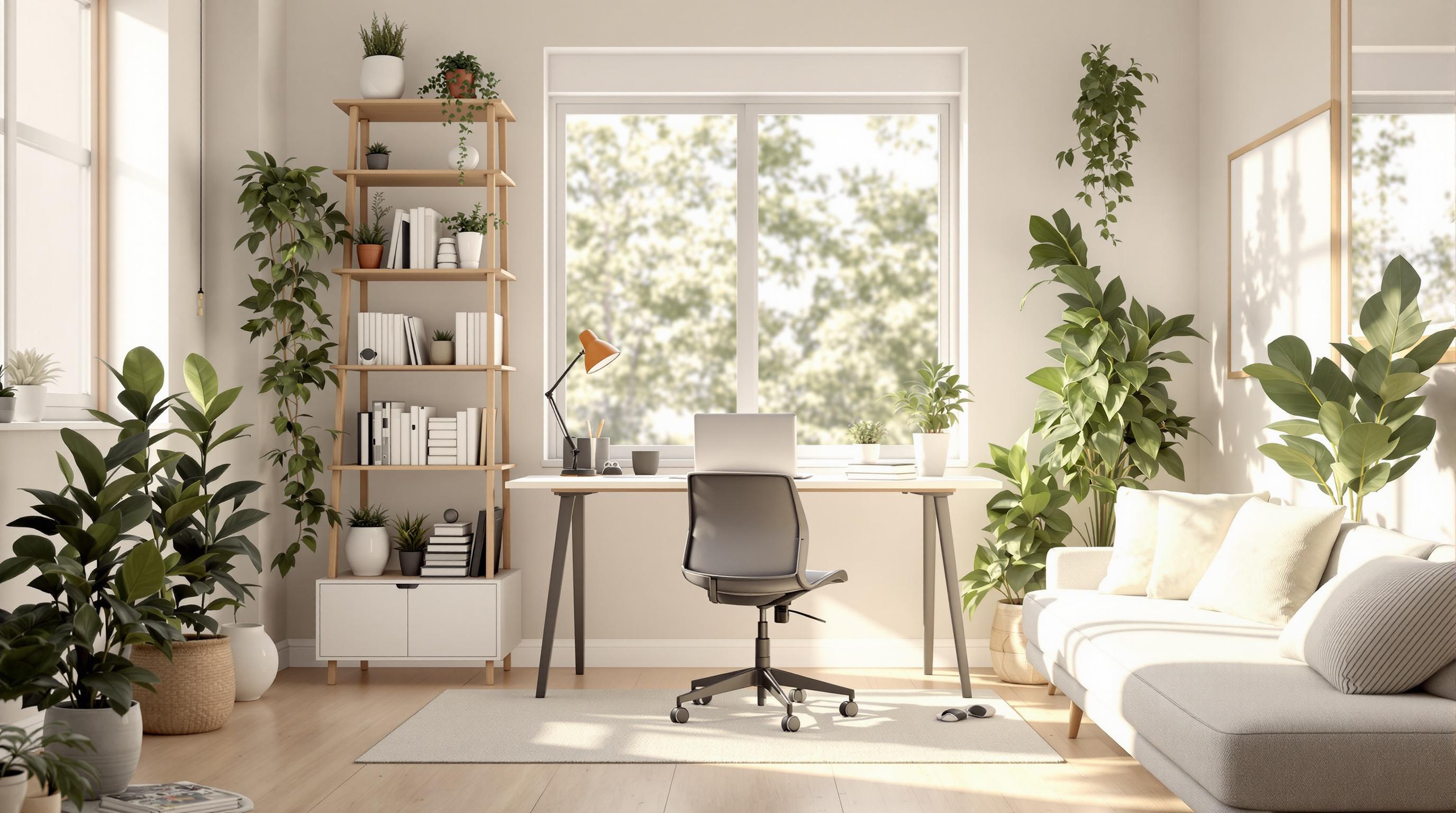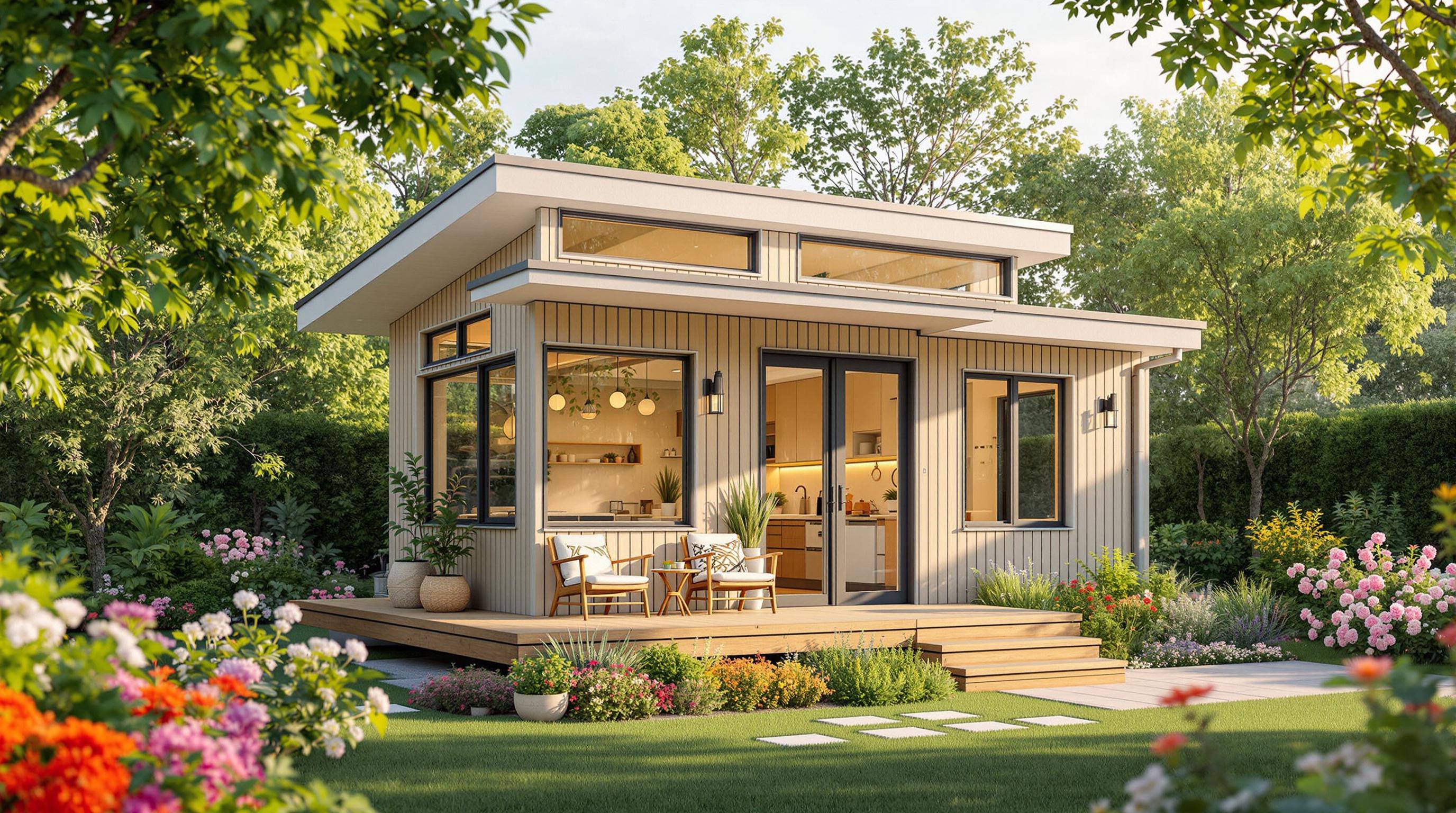Building a tiny house in Florida is easier than you might think, but it requires careful planning. Florida is one of the more tiny house-friendly states, with laws allowing homes under 400 sq. ft. and even movable tiny homes for year-round living. Here's what you need to know:
- Zoning Laws: Rules vary by county. For example, Orange County allows tiny homes on wheels as accessory dwelling units (ADUs), while Pasco County requires permanent foundations.
- Building Codes: Florida defines tiny houses as homes under 400 sq. ft. (excluding lofts). Key requirements include emergency escape windows, minimum ceiling heights, and hurricane-resistant construction.
- Permits: You’ll need building, plumbing, and electrical permits. Movable tiny homes must also be registered with the Department of Highway Safety and Motor Vehicles.
- Best Locations: Tiny house-friendly areas include St. Petersburg, Hamilton County, and Dixie County. Research local rules before buying land.
- Hurricane-Resistant Design: Use reinforced materials, permanent anchoring, and impact-resistant windows to withstand Florida’s storms.
- Energy Efficiency: Solar panels, moisture-resistant materials, and proper ventilation are great for Florida’s climate.
Whether you’re building on wheels or a foundation, Florida offers plenty of options for tiny house living. Just make sure to follow local rules and design for the state’s unique weather challenges.
Florida Tiny House Laws You Should Know
Florida Zoning Laws for Tiny Houses
Understanding Florida's zoning laws is crucial for anyone planning a tiny house project, as rules differ significantly across counties. Since Orange County introduced its ADU rule in 2018, more regions in Florida have started to embrace tiny homes.
Zoning Rules in Key Florida Counties
Each Florida county approaches tiny house regulations differently, aiming to balance creativity with safety. Counties like Orange, Sarasota, Pasco, and Dixie have established their own guidelines. For example, Orange County permits tiny houses on wheels under 400 sq. ft. as ADUs, while Sarasota and Pasco focus on homes with permanent foundations that comply with local building codes [1].
| County | Key Regulations |
|---|---|
| Orange | Allows tiny houses on wheels (max 400 sq. ft.) as ADUs; must meet safety standards. |
| Sarasota | Recognizes tiny houses; specific rules depend on location within the county. |
| Pasco | Requires permanent foundations; homes must comply with the Florida Building Code. |
How to Check Land Use Compatibility
Start by contacting your local building department to verify zoning rules and ensure your project complies with the Florida Building Code, which outlines safety and structural standards [5]. Many departments provide online zoning maps and resources to help with initial research.
If zoning laws seem overwhelming, a land use attorney can make the process easier. They can assist with:
- Interpreting regulations
- Handling paperwork
- Resolving zoning conflicts
- Securing required permits
Legislation such as CS/HB 557 has paved the way for movable tiny homes, but local zoning restrictions still govern their placement [3]. After confirming zoning compliance, the next step is ensuring your tiny house meets all Florida building code requirements.
Florida Building Codes and Legal Steps for Tiny Houses
The Florida Building Code outlines specific rules for tiny houses, categorizing them as homes with a maximum of 400 square feet, not including lofts. Following these rules is key to ensuring your tiny home meets legal standards.
Tiny House Requirements in Florida Building Code
Florida's regulations for tiny homes are detailed and focus on safety and livability. For example, all tiny houses must have emergency escape and rescue openings in sleeping areas for safety reasons [5].
| Building Element | Requirement |
|---|---|
| Maximum Floor Area | 400 sq ft (excluding lofts) |
| Habitable Space Ceiling Height | At least 6'8" |
| Bathroom/Kitchen Ceiling Height | At least 6'4" |
| Emergency Escape | Required in sleeping areas |
| Foundation Type | Permanent or mobile (chassis-mounted) |
As of 2024, Florida permits year-round living in movable tiny homes, provided they meet the Florida Building Code [3].
Permits and Approvals You’ll Need
Before diving into construction, check local zoning laws to confirm where tiny homes are allowed [1].
| Permit Type | Purpose | Key Requirements |
|---|---|---|
| Building Permit | Ensures structural and zoning compliance | Construction plans, site plans |
| Electrical Permit | Verifies safe electrical system installation | Circuit diagrams, load calculations |
| Plumbing Permit | Approves water and waste system installation | Plumbing layouts, fixture details |
To get these permits, you’ll need to submit detailed construction plans that demonstrate compliance with the code [1][2]. If your tiny house is on a chassis or trailer, it must also be registered with the Department of Highway Safety and Motor Vehicles [3].
Once your plans and permits are sorted, the next step is finding the perfect spot in Florida for your tiny home.
Selecting a Location for Your Tiny House in Florida
Choosing the right spot for your tiny house in Florida takes some planning. You'll need to look into local rules and consider factors like weather risks and infrastructure. As of 2025, several counties in Florida have become more welcoming to tiny homes, giving you plenty of options.
Top Counties for Tiny House Living
Some Florida counties stand out for their tiny house-friendly policies. For example:
- St. Petersburg allows homes between 375 and 700 square feet, offering flexibility [4].
- Hamilton County permits foundation-based tiny homes with a minimum size of just 100 square feet.
- Dixie County is actively updating its rules to accommodate mobile tiny houses.
| County | Key Features | Size Requirements |
|---|---|---|
| Hamilton County | Foundation-only homes permitted | Min 100 sq ft |
| Dixie County | Updating regulations for mobile tiny homes | Varies |
| St. Petersburg | Flexible zoning options | 375-700 sq ft |
Tips for Finding the Right Land
Working with real estate agents who specialize in tiny homes can make the process smoother. When you’re scouting for land, here are some key things to keep in mind:
- Environmental Risks: Use FEMA flood maps to check for flood zones and assess hurricane risks.
- Infrastructure: Make sure the land has access to water, electricity, and sewage systems.
- Local Rules: Confirm setback distances, minimum lot sizes, and other zoning requirements.
Websites like tinyhousesearch.com can help you find properties that allow tiny homes. Before making a purchase, double-check these details with local authorities:
- Zoning restrictions
- Minimum square footage requirements
- Foundation rules
- Utility connection needs
Your choice of location isn’t just about following the rules - it’s also about finding a place that suits your lifestyle and goals. For instance, Sarasota County has different requirements depending on the specific area [1].
If you’re unsure about zoning laws, consulting a land use attorney can help you avoid costly mistakes. Once you’ve secured your spot, the next step is designing a tiny house that can handle Florida’s unique challenges, like hurricanes and high humidity.
sbb-itb-2ef3f3a
Building Practices for Florida's Climate
Florida's climate presents unique challenges for tiny house construction. The combination of high humidity, intense sun, and hurricane risks requires thoughtful building strategies to ensure durability and comfort.
Hurricane-Resistant Building Tips
To handle Florida's strong winds and storms, your tiny home needs specific design features:
| Feature | Specification | Purpose |
|---|---|---|
| Windows | ASTM E1886 rated | Shields against wind-borne debris |
| Roofing | Reinforced materials | Increases wind resistance |
| Foundation | Permanent anchoring | Adds structural stability |
| Frame | Reinforced steel | Boosts overall durability |
Adding storm shutters and impact-resistant windows can provide extra protection and may even lower your insurance premiums.
"In Florida, it's not just about building a house, it's about building a house that can withstand the forces of nature." - Dr. Jennifer Jurado, Director of the Broward County Environmental Planning and Community Resilience Division [4]
These features are critical for ensuring your tiny house can weather Florida's extreme conditions.
Smart Material Choices and Energy Efficiency
Building for Florida's climate also means choosing materials and systems that work with the environment, not against it:
Key Sustainable Building Elements:
- Use reclaimed or locally sourced materials to cut down on transportation costs and environmental impact.
- Opt for moisture-resistant materials and low-VOC paints to handle humidity and maintain air quality.
- Incorporate solar panels, large windows, and energy-efficient appliances to reduce electricity usage.
- Select materials with high thermal mass to help regulate indoor temperatures naturally, reducing the need for air conditioning.
A rainwater harvesting system is another smart addition. It helps conserve water and can lower utility costs, especially in Florida's rainy seasons. The Insurance Institute for Business & Home Safety (IBHS) also advises installing proper ventilation systems to effectively manage the state's high humidity levels.
With these strategies, you're well on your way to creating a sturdy and comfortable tiny home tailored to Florida's unique environment.
Resources for Tiny House Builders in Florida
Florida Government and Zoning Resources
If you're planning to build a tiny house in Florida, understanding the state's regulations is crucial. The Florida Department of Business and Professional Regulation (DBPR) is a key resource for building code details, while county websites provide zoning maps and permit application guidelines.
| Resource Type | Where to Find | Purpose |
|---|---|---|
| Building Codes | Florida Building Code website | Learn construction standards for tiny houses |
| Zoning Maps | County government portals | Check land use rules and restrictions |
| Permit Applications | Local building departments | Submit required documents for approvals |
For example, Orange County's website highlights their 2018 rule allowing tiny houses on wheels as accessory dwelling units (ADUs) up to 400 square feet [1]. Sarasota County also offers specific guidelines for tiny house projects within their area [1].
"Consulting with a land use attorney can simplify navigating Florida's zoning ordinances."
Once you’ve reviewed these resources, you can move on to finding builders and communities to turn your tiny house dream into reality.
Directories and Builders for Tiny Houses
Florida's tiny house movement has gained momentum, with established builders and communities paving the way. Communities like the Orlando Lake Magic RV Resort and the Tiny House Village in St. Petersburg provide great examples of thriving tiny house living and networking opportunities [4].
Platforms like Tiny Houses For Sale, Rent, and More are a great starting point. They offer directories to help you connect with:
- Licensed tiny house builders in Florida
- Land listings and properties suited for tiny houses
- DIY resources for those looking to build their own tiny home
The Florida Building Commission regularly updates regulations for movable tiny homes, so staying informed is key. Partnering with experienced builders and established communities ensures your project meets current standards and benefits from expert guidance.
Conclusion: Key Points for Building a Tiny House in Florida
Building a tiny house in Florida takes careful planning and a good understanding of local laws and the state’s climate. To succeed, you need to balance legal requirements with practical design choices.
Legal Requirements to Keep in Mind
Zoning laws play a big role in tiny house construction in Florida. Since these rules differ from county to county, researching your chosen location is a must.
| Building Aspect | Key Details |
|---|---|
| Size Restrictions | Ranges from 375 to 1,500 sq ft, depending on the county |
| Foundation Options | Can be either permanent or mobile |
Planning and Professional Help
The Florida Department of Business and Professional Regulation offers resources to help you understand building codes. To stay on track, consider working with licensed builders and consulting local officials. This approach can help you meet zoning requirements and avoid unnecessary setbacks.
Designing for Florida’s Climate
Florida’s weather demands thoughtful design. Use hurricane-resistant materials, energy-saving systems, and proper moisture control to ensure your tiny house is both durable and comfortable.
Building a Support Network
Joining Florida’s tiny house communities can be incredibly helpful. These groups offer networking opportunities and share practical advice from people who’ve been through the process.
FAQs
Where in Florida can you put a tiny home?
You can set up a tiny home in places like Orange County or cities such as St. Petersburg, Oviedo, and Casselberry, but the specifics vary. For example, St. Petersburg requires tiny homes to be between 375 and 700 square feet [4].
| Location | Key Requirements |
|---|---|
| Orange County | Maximum of 400 sq ft for accessory dwelling units (ADUs) on wheels |
| St. Petersburg | Must fall within 375-700 sq ft |
| Sarasota County | Requirements differ across the county |
Where to park a tiny home in Florida?
Florida's zoning laws offer several choices for parking tiny homes, depending on the type of foundation and local rules. Options include designated tiny house communities, RV parks, and private or rural properties. Movable tiny homes, such as tiny houses on wheels (THOWs), are allowed for year-round living if they comply with Florida Building Code standards, as per HB 557 [3].
Can I put a tiny house on my property in Florida?
Yes, you can, provided you follow local zoning rules and meet Florida Building Code standards. This includes adhering to size and foundation requirements. According to the Florida Building Code, a tiny house is defined as a dwelling with a floor area of 400 square feet or less, not counting lofts [3][5].
"HB 557 allows movable tiny homes built in accordance with the Florida Building Code to be used for year-round living, effective October 1, 2024" [3]
Being aware of these guidelines will help ensure your tiny home project follows Florida's regulations.



